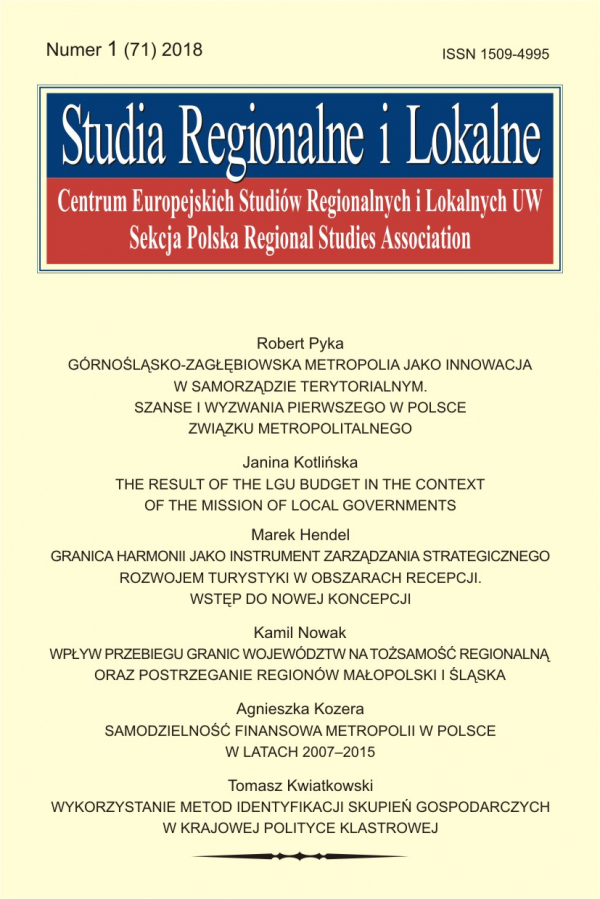Issue:
1(71)/2018
Robert Pyka
The Upper Silesian and Zagłębie Metropolis as a local government innovation. Poland’s first metropolitan union – opportunities and threats
DOI: 10.7366/1509499517101
Górnośląsko-Zagłębiowska Metropolia jako innowacja w samorządzie terytorialnym. Szanse i wyzwania pierwszego w Polsce związku metropolitalnego
Po ponad 10 latach dyskusji na temat potrzeby upodmiotowienia obszarów metropolitalnych w Polsce przyjęta została ostatecznie ustawa o związku metropolitalnym w województwie śląskim. Wyznaczenie pułapu demograficznego na poziomie 2 mln mieszkańców potwierdza, że zamierzeniem ustawodawcy było stworzenie pierwszego związku metropolitalnego właśnie w konurbacji górnośląskiej, co podyktowane jest jej unikatową w skali kraju strukturą terytorialną. Powstanie z dniem 1 lipca 2017 r. Górnośląsko-Zagłębiowskiej Metropolii jest zatem wielkim eksperymentem społecznym i znaczącą innowacją w polskim samorządzie terytorialnym. Objęcie zasięgiem związku metropolitalnego 41 gmin górnośląskiego obszaru metropolitalnego było odważnym krokiem i świadczy o wysokim poziomie mobilizacji i determinacji śląskich samorządowców. Specyficzny system decyzyjny oparty na zasadzie podwójnej większości powinien sprzyjać dialogowi dużych i małych gmin związku metropolitalnego. Ogólnie sformułowane w ustawie kompetencje związku dają istotną swobodę jego władzom w wyznaczeniu priorytetowych zadań i projektów. Celem autora artykułu jest analiza architektury instytucjonalnej związku metropolitalnego, będącego połączeniem związku komunalnego i jednostki samorządu terytorialnego, w perspektywie możliwości budowy efektywnego systemu metropolitalnego współrządzenia w górno-śląskim obszarze metropolitalnym.
The Upper Silesian and Zagłębie Metropolis as a local government innovation. Poland’s first metropolitan union – opportunities and threats
After 10 years of discussions about the need to empower the metropolitan areas in Poland, finally a metropolitan union law for the Śląskie Voivodeship [Silesian region] has been adopted. Defining two million people as a population level required for the creation of the metropolitan union confirmed that the legislator’s intention was to establish the first metropolitan union in Poland specifically in the Silesian conurbation due to its unique territorial structure. The establishment of the Upper Silesian and Zagłębie Metropolis [Górnośląsko-Zagłębiowska Metropolia] should be seen as an important social experiment and significant innovation in the Polish local – government system. The large territorial delimitation of the metropolitan union with 41 local units is a courageous step that proves a high level of mobilisation and strong involvement of Silesian local decision makers. The specific decision-making procedure based on double majority voting should entourage dialogue between the large and small member cities of the metropolitan union. The generally formulated competences of the metropolitan union allow considerable freedom to the authorities in prioritising tasks and projects. The author’s analyses the institutional architecture of the first Polish metropolitan union, which is a hybrid organisation combining an inter-municipal association and a local government unit, from the perspective of turning the Upper Silesian metropolitan area into an efficient system of metropolitan governance.
Affiliation:
Robert Pyka: Uniwersytet Śląski, Obserwatorium Procesów Miejskich i Metropolitalnych, ul. Bankowa 12, 40-007 Katowice;
robert.pyka@us.edu.pl 


